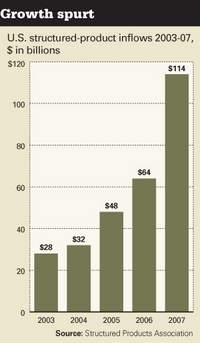Straight From The Source:
Written by Heather Bell
Tuesday, 29 April 2008 11:19
Index Universe (IU): Why did Barclays Capital create its family of ETNs?
Philippe El-Asmar (El-Asmar): We created the iPath family to complement the existing iShares ETFs that Barclays Global Investors were offering. They are meant to give access to more difficult-to-reach asset classes.
IU: How does a decision get made as to whether an index will be used to underlie an ETF or an ETN?
El-Asmar: It's a very close collaboration and partnership that we have between BGI and Barclays Capital, and we regularly meet to discuss the plans for the next three-to-six months, or the next year or possibly even longer-term plans. The first priority is to basically give investors choices and respond to the needs of clients. The primary driver for us in launching a product is not our agenda, but more the response to feedback we've collected from clients over time. We're pretty agnostic with regard to the choice between one instrument and the other. Often there is value in each of the instruments depending on what the investor really wants, and in the past, we have offered an ETN and an ETF tracking the same underlying index. Generally speaking, we collaboratively try to fill the gaps using ETNs as a means to access more difficult-to-reach markets and ETFs as the traditional vehicle.
IU: Beyond the collaboration with BGI, what is driving the expansion of the iPath ETN family?
El-Asmar: The primary driver here is providing the clients with what they want and giving them choices. We didn't try to launch hundreds of ETNs and just hope that some will succeed. We've always been very cautious about providing investment products that we think will see long-term demand from investors. Commodities, for example, are in everybody's mind as an established asset class, but four years ago. very few people had exposure to commodities. We're not saying when we launch a commodity ETN that right now is the right time to invest in commodities. What we're saying is if you decided to invest in commodities, this is the best way you can access the data class-a very simple, transparent, cost-efficient way, with the convenience of trading on an exchange.
IU: Barclays Bank was the first in the ETN space. Do you see a lot of new players coming into the field beyond the ones that are currently there now?
El-Asmar: Yes; we know of at least two other banks that are working very seriously on their exchange-traded note platforms. We've had, since we entered the market in 2006, about six or seven separate issuers create ETNs themselves as well.
IU: Are there high barriers to entry to the market? Barclays was kind of out there by itself for a while.
El-Asmar: I think it does take a lot of time and energy and effort to create the architecture around an exchanged-traded note program, and often the first is the most difficult to do. So yes, it does take time for other issuers to catch up, but relatively speaking, we were in the market uncontested for about a year, and that might have been a little bit longer than what we anticipated. Typically speaking, it would have taken maybe six months for the competition to copy us.
For the full interview on IndexUniverse.com, click here.
Thursday, May 1, 2008
Subscribe to:
Comments (Atom)


